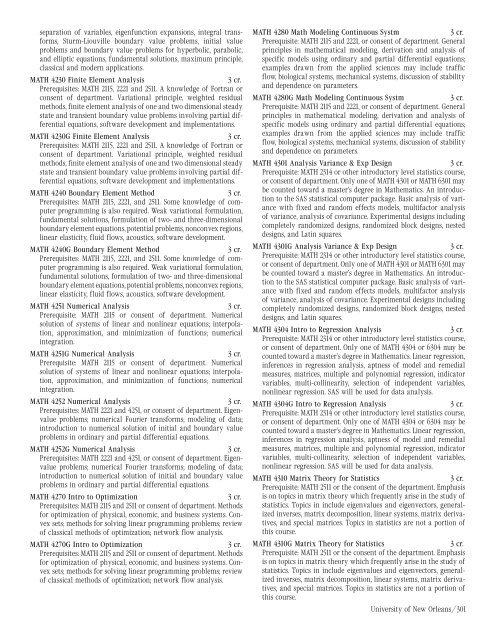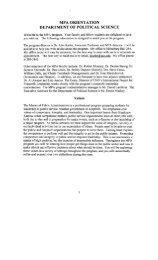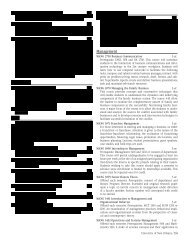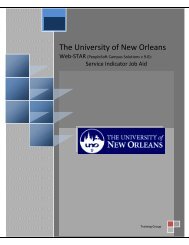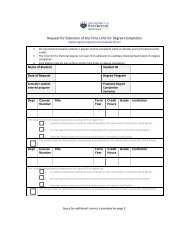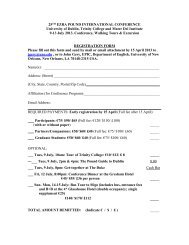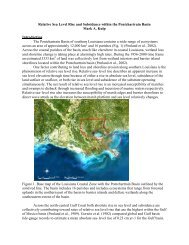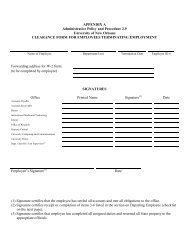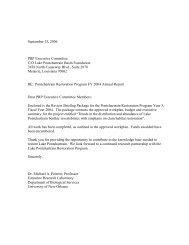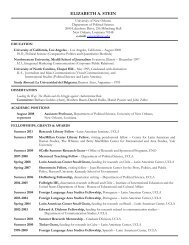Untitled - University of New Orleans
Untitled - University of New Orleans
Untitled - University of New Orleans
Create successful ePaper yourself
Turn your PDF publications into a flip-book with our unique Google optimized e-Paper software.
separation <strong>of</strong> variables, eigenfunction expansions, integral transforms,<br />
Sturm-Liouville boundary value problems, initial value<br />
problems and boundary value problems for hyperbolic, parabolic,<br />
and elliptic equations, fundamental solutions, maximum principle,<br />
classical and modern applications.<br />
MATH 4230 Finite Element Analysis<br />
3 cr.<br />
Prerequisites: MATH 2115, 2221 and 2511. A knowledge <strong>of</strong> Fortran or<br />
consent <strong>of</strong> department. Variational principle, weighted residual<br />
methods, finite element analysis <strong>of</strong> one and two dimensional steady<br />
state and transient boundary value problems involving partial differential<br />
equations, s<strong>of</strong>tware development and implementations.<br />
MATH 4230G Finite Element Analysis<br />
3 cr.<br />
Prerequisites: MATH 2115, 2221 and 2511. A knowledge <strong>of</strong> Fortran or<br />
consent <strong>of</strong> department. Variational principle, weighted residual<br />
methods, finite element analysis <strong>of</strong> one and two dimensional steady<br />
state and transient boundary value problems involving partial differential<br />
equations, s<strong>of</strong>tware development and implementations.<br />
MATH 4240 Boundary Element Method<br />
3 cr.<br />
Prerequisites: MATH 2115, 2221, and 2511. Some knowledge <strong>of</strong> computer<br />
programming is also required. Weak variational formulation,<br />
fundamental solutions, formulation <strong>of</strong> two- and three-dimensional<br />
boundary element equations, potential problems, nonconvex regions,<br />
linear elasticity, fluid flows, acoustics, s<strong>of</strong>tware development.<br />
MATH 4240G Boundary Element Method<br />
3 cr.<br />
Prerequisites: MATH 2115, 2221, and 2511. Some knowledge <strong>of</strong> computer<br />
programming is also required. Weak variational formulation,<br />
fundamental solutions, formulation <strong>of</strong> two- and three-dimensional<br />
boundary element equations, potential problems, nonconvex regions,<br />
linear elasticity, fluid flows, acoustics, s<strong>of</strong>tware development.<br />
MATH 4251 Numerical Analysis<br />
3 cr.<br />
Prerequisite: MATH 2115 or consent <strong>of</strong> department. Numerical<br />
solution <strong>of</strong> systems <strong>of</strong> linear and nonlinear equations; interpolation,<br />
approximation, and minimization <strong>of</strong> functions; numerical<br />
integration.<br />
MATH 4251G Numerical Analysis<br />
3 cr.<br />
Prerequisite: MATH 2115 or consent <strong>of</strong> department. Numerical<br />
solution <strong>of</strong> systems <strong>of</strong> linear and nonlinear equations; interpolation,<br />
approximation, and minimization <strong>of</strong> functions; numerical<br />
integration.<br />
MATH 4252 Numerical Analysis<br />
3 cr.<br />
Prerequisites: MATH 2221 and 4251, or consent <strong>of</strong> department. Eigenvalue<br />
problems; numerical Fourier transforms; modeling <strong>of</strong> data;<br />
introduction to numerical solution <strong>of</strong> initial and boundary value<br />
problems in ordinary and partial differential equations.<br />
MATH 4252G Numerical Analysis<br />
3 cr.<br />
Prerequisites: MATH 2221 and 4251, or consent <strong>of</strong> department. Eigenvalue<br />
problems; numerical Fourier transforms; modeling <strong>of</strong> data;<br />
introduction to numerical solution <strong>of</strong> initial and boundary value<br />
problems in ordinary and partial differential equations.<br />
MATH 4270 Intro to Optimization<br />
3 cr.<br />
Prerequisites: MATH 2115 and 2511 or consent <strong>of</strong> department. Methods<br />
for optimization <strong>of</strong> physical, economic, and business systems. Convex<br />
sets; methods for solving linear programming problems; review<br />
<strong>of</strong> classical methods <strong>of</strong> optimization; network flow analysis.<br />
MATH 4270G Intro to Optimization<br />
3 cr.<br />
Prerequisites: MATH 2115 and 2511 or consent <strong>of</strong> department. Methods<br />
for optimization <strong>of</strong> physical, economic, and business systems. Convex<br />
sets; methods for solving linear programming problems; review<br />
<strong>of</strong> classical methods <strong>of</strong> optimization; network flow analysis.<br />
MATH 4280 Math Modeling Continuous Systm<br />
3 cr.<br />
Prerequisite: MATH 2115 and 2221, or consent <strong>of</strong> department. General<br />
principles in mathematical modeling, derivation and analysis <strong>of</strong><br />
specific models using ordinary and partial differential equations;<br />
examples drawn from the applied sciences may include traffic<br />
flow, biological systems, mechanical systems, discussion <strong>of</strong> stability<br />
and dependence on parameters.<br />
MATH 4280G Math Modeling Continuous Systm<br />
3 cr.<br />
Prerequisite: MATH 2115 and 2221, or consent <strong>of</strong> department. General<br />
principles in mathematical modeling, derivation and analysis <strong>of</strong><br />
specific models using ordinary and partial differential equations;<br />
examples drawn from the applied sciences may include traffic<br />
flow, biological systems, mechanical systems, discussion <strong>of</strong> stability<br />
and dependence on parameters.<br />
MATH 4301 Analysis Variance & Exp Design<br />
3 cr.<br />
Prerequisite: MATH 2314 or other introductory level statistics course,<br />
or consent <strong>of</strong> department. Only one <strong>of</strong> MATH 4301 or MATH 6301 may<br />
be counted toward a master’s degree in Mathematics. An introduction<br />
to the SAS statistical computer package. Basic analysis <strong>of</strong> variance<br />
with fixed and random effects models, multifactor analysis<br />
<strong>of</strong> variance, analysis <strong>of</strong> covariance. Experimental designs including<br />
completely randomized designs, randomized block designs, nested<br />
designs, and Latin squares.<br />
MATH 4301G Analysis Variance & Exp Design<br />
3 cr.<br />
Prerequisite: MATH 2314 or other introductory level statistics course,<br />
or consent <strong>of</strong> department. Only one <strong>of</strong> MATH 4301 or MATH 6301 may<br />
be counted toward a master’s degree in Mathematics. An introduction<br />
to the SAS statistical computer package. Basic analysis <strong>of</strong> variance<br />
with fixed and random effects models, multifactor analysis<br />
<strong>of</strong> variance, analysis <strong>of</strong> covariance. Experimental designs including<br />
completely randomized designs, randomized block designs, nested<br />
designs, and Latin squares.<br />
MATH 4304 Intro to Regression Analysis<br />
3 cr.<br />
Prerequisite: MATH 2314 or other introductory level statistics course,<br />
or consent <strong>of</strong> department. Only one <strong>of</strong> MATH 4304 or 6304 may be<br />
counted toward a master’s degree in Mathematics. Linear regression,<br />
inferences in regression analysis, aptness <strong>of</strong> model and remedial<br />
measures, matrices, multiple and polynomial regression, indicator<br />
variables, multi-collinearity, selection <strong>of</strong> independent variables,<br />
nonlinear regression. SAS will be used for data analysis.<br />
MATH 4304G Intro to Regression Analysis<br />
3 cr.<br />
Prerequisite: MATH 2314 or other introductory level statistics course,<br />
or consent <strong>of</strong> department. Only one <strong>of</strong> MATH 4304 or 6304 may be<br />
counted toward a master’s degree in Mathematics. Linear regression,<br />
inferences in regression analysis, aptness <strong>of</strong> model and remedial<br />
measures, matrices, multiple and polynomial regression, indicator<br />
variables, multi-collinearity, selection <strong>of</strong> independent variables,<br />
nonlinear regression. SAS will be used for data analysis.<br />
MATH 4310 Matrix Theory for Statistics<br />
3 cr.<br />
Prerequisite: MATH 2511 or the consent <strong>of</strong> the department. Emphasis<br />
is on topics in matrix theory which frequently arise in the study <strong>of</strong><br />
statistics. Topics in include eigenvalues and eigenvectors, generalized<br />
inverses, matrix decomposition, linear systems, matrix derivatives,<br />
and special matrices. Topics in statistics are not a portion <strong>of</strong><br />
this course.<br />
MATH 4310G Matrix Theory for Statistics<br />
3 cr.<br />
Prerequisite: MATH 2511 or the consent <strong>of</strong> the department. Emphasis<br />
is on topics in matrix theory which frequently arise in the study <strong>of</strong><br />
statistics. Topics in include eigenvalues and eigenvectors, generalized<br />
inverses, matrix decomposition, linear systems, matrix derivatives,<br />
and special matrices. Topics in statistics are not a portion <strong>of</strong><br />
this course.<br />
<strong>University</strong> <strong>of</strong> <strong>New</strong> <strong>Orleans</strong>/301


